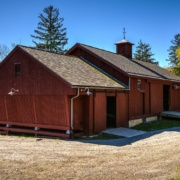Every now and again a prospective client comes through our door with a set of drawings from another timber frame company. For one reason or another — why is usually a somewhat delicate matter — the prospective client decided they weren’t sure they wanted to work with that company. Or maybe they were really sure. In any event, this can and should raise a few red flags, kind of like when you find out that a new acquaintance is on his or her fourth marriage. One of those flags has to do with the question of who owns the rights to those drawings.
Copyright infringement is a serious offense. In fact, it’s a federal offense. Really. Copyright suits are tried in federal court. And juries overwhelmingly favor the allegedly aggrieved party. Moreover, fines and legal costs can be literally staggering. I don’t personally know of any timber frame companies that have been put out of business by a copyright infringement suit, but I’ve heard of one suing another enough times. And there certainly are cases of construction companies going belly up over such a suit. What the aggrieved party stands to gain by suing, of course, is rightful payment for the use of his or her intellectual property, and, as expected, there are plenty of lawyers around who are interested in helping him or her gain that, and to gain their own pound of flesh to boot. It’s been said that copyright attorneys are the new personal injury lawyers. Yep, there’s gold in them thar hills.
So the first delicate question that crosses our lips when we see someone else’s drawings is “Have you paid for these drawings?” When you think of it, it’s really just a common courtesy we timber framers should pay one another. Nobody thinks that timber framers shouldn’t be competing with one another. A little healthy competition is good for timber framers, for the industry as a whole, and for the client. But that doesn’t mean ripping off someone else’s ideas. When we send a client a set of conceptual drawings in a bid package, we put a polite request right in the title block: “Please respect our investment of time and resources in the creation of these drawings… .” Basically, what we’re asking is that if the client wants competing bids, they should also be looking for competing designs. And if a timber frame company wants to compete with us, they should come up with their own designs, too. We’ve made it a policy to accord each and every client and competitor the same respect. Whenever we see a set of some other company’s drawings we call that company to make sure they have been properly remunerated for their work and that we have the right to bid from their drawings.
What exactly constitutes copyright infringement, however, is wide open to interpretation. The law says that a design should demonstrate “substantial difference” from another design, yet there is no clear set of guidelines to establish substantial difference. Is it a percentage of difference? And where do we learn to do that math? When it comes to timber frame designs, or even just architectural residential designs for that matter, the range of possibilities is infinite. A common formula, if you will, for our residential timber frame designs is a front porch, a great room, and a kitchen-dining area off to one side. Within the design parameters that a client sets there are only so many permutations of that frame design, and it’s not necessarily easy for the layman to distinguish them. So when a client says that timber frame company X has submitted a design and budget proposal, we often think it’s best if he or she leaves the drawings at home and just shows us the house design — presumably also paid for.
One of the most rewarding parts of my work here at Lancaster County Timber Frames is the personal connection that develops between me and my clients over the course of a successful project. If copyright issues get injected into that process, it can make it a lot harder for that connection to develop. Getting the copyright question — if there is one — on the table right away and handling it as ethics, courtesy, and the law require is the only course.
– Tim Diener









